
“To find me, look in the corner of the shop, over here, behind the cobwebs, beneath the dust, in the darkness. There are scores of us, broken handles, dulled blades, cracked iron. Some of us were useful once, and then… many of us never were. But, listen, don’t feel sorry for me. Life ain’t so bad here in the pile… no work, no anvils, no pain, no sharpening, and yet the days are very long.” (p17)
With a strong forearm, the apron clad blacksmith puts his tongs into the fire, grasps the heated metal, and places it on his anvil. His keen eye examines the glowing piece. He sees what the tools is now and envisions what he wants it to be–sharper, flatter, wider, longer. With a clear picture in his mind, he begins to pound. His left hand still clutching the hot mass with the tongs, the right hand slams the two-pound sledge upon the moldable metal. On the solid anvil, the smoldering iron is remolded.
The smith knows the type of instrument he wants. He knows the size. He knows the shape. He knows the strength. Wang! Wang! The hammer slams. The shop rings with noise, the air fills with smoke and the softened metal responds. But the response doesn’t come easily. It doesn’t come without discomfort. To melt down the old and recast the new is a disrupting process. Yet the metal remains on the anvil, allowing the toolmaker to remove the scars, repair the cracks, refill the voids, and purge the impurities.
And, with time, a change occurs: what was dull becomes sharpened; what was crooked becomes straight; what was weak becomes strong; and what was useless becomes valuable. Then the blacksmith stops. He ceases his pounding and sets down his hammer. With a strong left arm, he lifts the tongs until the freshly molded metal is at eye-level.
In the still silence he examines the smoking tool. The incandescent implement is rotated and examined for any mars or cracks. There are none. Now the smith enters the final stage of his task. He plunges the smoldering instrument into a nearby bucket of water. With a hiss and a rush of smoke, the metal immediately begins to harden. The heat surrenders to the onslaught of cool water and the pliable, soft mineral becomes an unbending, useful tool….(I Pet. 1:7,7) (pp47-48)
“An instrument is useful only if it’s in the right shape. A dull axe or a bent screwdriver needs attention, and so do we. A good blacksmith keeps his tools in shape. So does God. Should God place you on the anvil, be thankful. It means he thinks you’re still worth reshaping.” (p50)
Author: Max Lucado
On the Anvil (ISBN 0-8423-4568-X)
 MORE IDEAS? See “Creative Object Lessons”
MORE IDEAS? See “Creative Object Lessons”
200 page e-book that explains everything you need to know when planning your very own object lessons. It contains 90 fully developed object lesson ideas and another 200 object lesson starter ideas based on Biblical idioms and Names / Descriptions of God.
